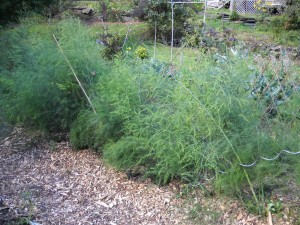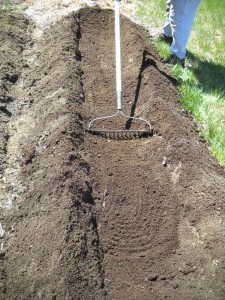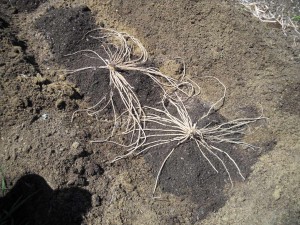Attention Lazy Gardeners: Asparagus is a (Nearly) Free Ride
As I am sure you know, once upon a time there were three little pigs. One built his house of bricks, one of sticks, and the lazy one built a house of straw. I forget the details, but I think the lazy one got eaten by the wolf – a moral for all kids and gardeners. Work hard, survive. But one exception to that rule is the asparagus patch. Each year you can have delicious food relatively work-free.
Okay, I exaggerate. There is considerable work in starting an asparagus patch, and a certain amount of work in keeping it weed-free. But it should come back reliably, year after year. So plant it well and keep it mulched to hold down weeds, and you can garner rewards year after year.
Twenty-five plants is a reasonable number of plants for a family of four, or for two people with my appetite for those sumptuous green spears. Asparagus needs rich soil with lots of nutrients, so have a good supply of compost or aged manure and some slow release organic fertilizer at planting time.
Get a soil test done before you plant, or get at least get a kit that will tell you the pH. Asparagus does best with a near neutral pH, in the range of 6.5 to 7.5. If your pH is less than 6.5 you will need to add limestone to “sweeten” the soil. The test kit will tell you how much limestone you need.
Before planting, dig out all weeds and especially grasses. Rototilling does not kill weeds and grasses, it just hides them. And they will come back to plague you for years. So weed well.
Because asparagus lasts for many years, it is important to enrich the soil more than you would for annual veggies like tomatoes or lettuce. In the old days –back when I was a kid – asparagus beds were dug deep, and manure was worked into the soil down to a depth of 18 inches. Asparagus roots were planted in a trench with the crown (where the roots originate) planted a foot deep and 18 inches apart.
Current thinking is that asparagus still needs good loose soil, but that the crown only need be planted 6 inches below the soil line. Using a hoe or shovel, create a trench 9 to 12 inches deep and 12 to 18 inches wide. Then loosen the soil in the bottom of the trench with a spading fork. Space rows 2 feet or more apart.
Plan on working in 4-6 inches of aged compost into the soil down at the depth where the roots will be, and in the soil you will use for backfilling the trench. Don’t skimp, even if you have good soil. Work the compost in with a spading fork or shovel. A rototiller would also do the job, but can adversely affect soil tilth or texture if done when the soil is too moist. And rototilling disturbs microorganisms and earthworms in the soil.
I also like to broadcast a generous dose of Pro-Gro or other slow-release organic fertilizer everywhere in the planting trench and mix it in. A quart yogurt container of organic fertilizer is fine for a dozen plants. Azomite, a mineral mix that provides micronutrients is a good additive, too. Green sand is an organic source of potassium and micronutrients from the sea. All of the above should be available at your local feed-and-grain store or garden center.
Asparagus roots are now sold that are all male – generally anything that has the word ‘Jersey’ in the name is all male (Is New Jersey a macho state?). ‘Martha Washington’ is the classic asparagus variety, but it has male and female plants, so they produce seeds – and little seedlings. This is not good. You don’t want extra seedlings growing in your patch, as they will compete with your plants for water and nutrients, just like weeds. Of course, you can pull the seedlings growing under Martha, and re-plant them elsewhere, but that sounds like work to me.
In the bottom of your trench build mounds of soil/compost mix. Drape the roots over the mounds with the crown sitting on top the mound. If the roots are longer than your trench is wide, swirl the roots around the mound a little. Then gently backfill your trench (or hole, if you did individual holes instead of a trench). Just an inch or two of soil is all that is required at the start. As the season progresses and the sprouts grow, add more soil/compost mix. By the end of the summer your plants should have 6 inches of soil over the crown.
A few recommendations: Have patience. Don’t pick any spears this year. Next year, just take one or two stalks per plant. Each year, take more – but never pick for more than 4 weeks. Taking too many spears will draw down their reserves and weaken the plants.
Keeping your asparagus patch well-weeded is important. Wood sides to an asparagus bed can help keep out creeping grasses, or you can dig a little moat around the bed to keep grasses from creeping in. Mulching with 6 pages of newspaper and 4 inches of straw will help keep down weeds and will hold in moisture.
Even if you are the quintessential third pig when it comes to gardening, don’t be lazy when planting asparagus. A little extra work now getting out weeds and working in healthy soil additives will pay you back many times over. Bon Appétit!
Henry Homeyer is a gardening consultant and author living in Cornish Flat, NH. His Web site is www.Gardening-guy.com.
End of Year Review
Recently I sent out an e-mail to a hundred or more readers of this column who had e-mailed me a question at some point. I wanted to see how people had done in 2012, and got lots of responses. I asked gardeners to respond to one or more of these prompts: In 2012 I was pleased to see that ….? I was surprised to see …? I was disappointed to see …?
 I’ll go first. I was pleased to see my new asparagus patch grew like crazy! I gave it lots of compost, some Pro-Gro organic fertilizer and a healthy dose of green sand. By fall I had 5 or more stems from each root, and most grew 3feet tall! My parsnips grew like crazy, as did onions … and all root crops.
I’ll go first. I was pleased to see my new asparagus patch grew like crazy! I gave it lots of compost, some Pro-Gro organic fertilizer and a healthy dose of green sand. By fall I had 5 or more stems from each root, and most grew 3feet tall! My parsnips grew like crazy, as did onions … and all root crops.
I was surprised to see how deeply my scorzonera (a first year for it) grew into the ground: 8-12 inches, even though each root was less than an inch in diameter. And each was a nearly perfect cylinder. It’s a lesser-known root crop, one that is cooked and eaten, not munched raw like carrots. It tasted good in the turkey stuffing or sautéed with other root vegetables. I was surprised that my beets grew so perfectly, even the ones that I had not thinned enough.
I was disappointed to see, once again, that various blights terminated my tomato harvest early. In the “old days” tomatoes kept on growing and producing fruit through September and into October. We covered them with blankets to keep the frost off them. But not anymore. Late blight finished them off by Labor Day. And of course, there was the impatiens downy mildew that killed impatiens off.
But many readers had great a great summer, due in part, to the sunny weather. Peg Sullivan wrote saying, “In 2012, I was pleased to see that everything I planted (and many things I didn’t!) grew beautifully. My gardens were full of color, flavor, and diversity and I didn’t have one crop failure or disappointment. I was pleasant surprised at the number of bees, butterflies and birds that visited my flower and herb gardens, and with a minor “high security” fence in my vegetable garden this year, I was able to fend off the pesky, but oh so comical woodchuck who hid under my zucchini leaves the prior year and demolished my kale crop. It was an incredible gardening season for me, and more of them like 2012 would be great!
Gary Milek of Cider Hill Gardens in Windsor, VT was surprised to see that he could eat fresh garden tomatoes in December. Last fall his wife, Sarah, pulled some ‘Juliet’ tomato plants that were loaded with green fruit and hung them upside in the garage, where they slowly ripened.
But many readers were disappointed by their losses to animals. Rebecca Tucker on the Black River in Springfield, VT wrote that “In 2012 I was disappointed in that, though I caught one woodchuck early in June in a hav-a-hart trap and delivered it to my neighbor for a stew, I spent the next two months trying to stay ahead of the second. … NEXT year, I’m building a chicken wire fence with a base of PT lumber buried 6 inches down all around the garden.” Many readers complained of the large numbers of mice and squirrels this year, probably due to the relatively snowless winter.
Reader Jan Polex noted that she was “Disappointed by the number of rabbits and what I needed to do to keep them out and also by my poor aim of my sling shot (was better last year)”.
Ruth Winkler of Cuttingsville, VT, among others, wrote that she “was disappointed in the fact that our apple trees this year did not provide us with any. The year before I had so many we were giving them away and I made lots of pies.” I think they will be back next summer – most of us had an unseasonably warm spell in April, followed by a hard frost that killed those buds that were already opening.
Brian Steinwand , recently retired, wrote that he was surprised by “how well some crops do in containers. I can grow a lot in a small amount of space, and even move some of those containers to follow the sun during the day.” I chuckle, thinking of Brian walking his tomatoes like a puppy on a leash! But more power to him! I’m not sure I will ever be able to do that – retire, that is.
Reader Daniel Duffy wrote, “In 2012 I was pleased to see that you were available when I had questions. I am a beginning gardener, just completing my second year. I have your book, Organic Gardening (Not Just) in the Northeast: A Hands-On Month-to-Month Guide, and it guided me Spring thru Fall, with tips, suggestions, guidelines which I was grateful to have. It was particularly useful because of its concentration on the Northeast. You also were kind enough to reply to my many E-mails sent to you. “ Thanks, Daniel. I don’t have the time to answer all questions, but I do try. My best wishes to all of you for the New Year. Let’s hope that next year will be even better than this year!
Wobar and the Quest for the Magic Calumet, Henry’s new children’s book, is available at his web site, www.henryhomeyer.com or your local bookstore. You may write Henry at P.O. Box 364, Cornish Flat, NH 03746 or e-mail him at henry.homeyer@comcast.net.





